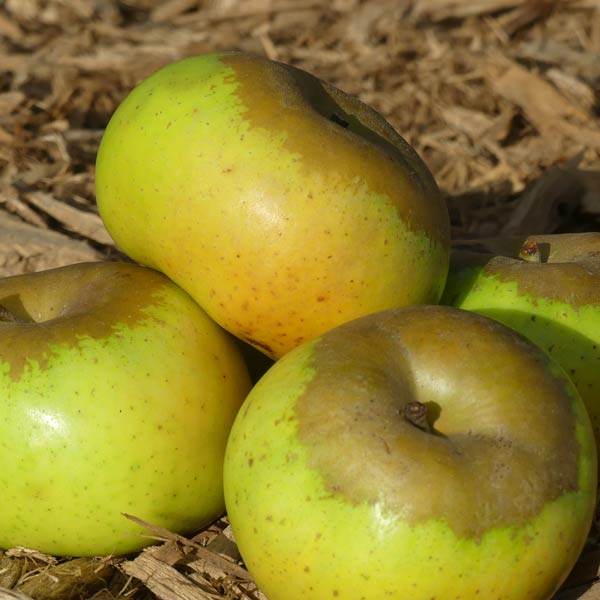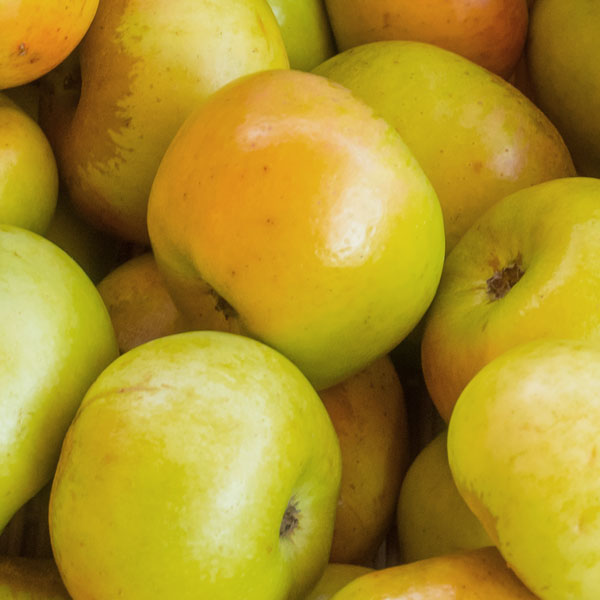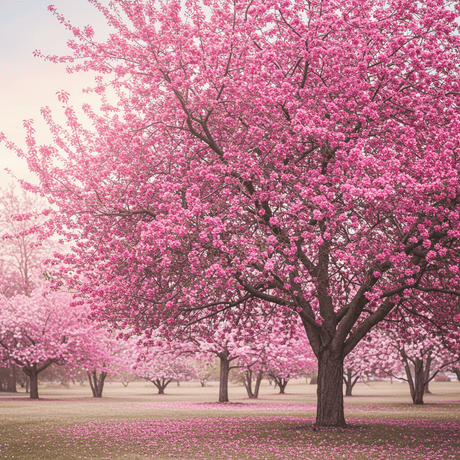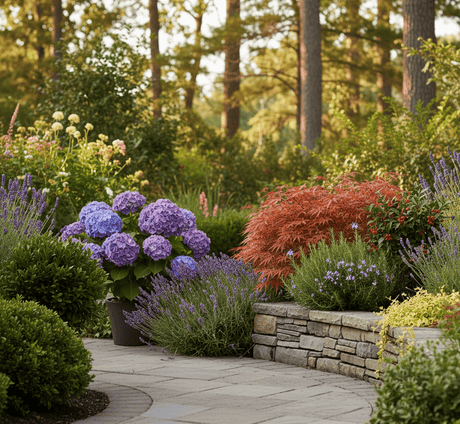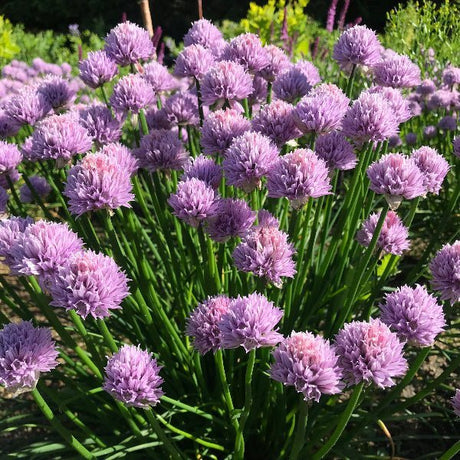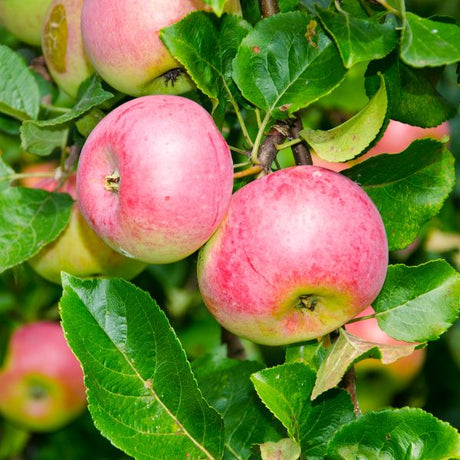Newtown Pippin Apple Tree
Malus 'Newtown Pippin'
- Stay Protected with Plant Sentry ™
Newtown Pippin Apple Tree - #3 Container 4-5 Feet is backordered and will ship as soon as it is back in stock.
Plant Sentry™
Plant Sentry™

Plant Sentry™ Protected
Your order is protected by our compliance system that:
- Prevents restricted plants from shipping to your state
- Ensures plants meet your state's agricultural requirements
- Protects gardens from invasive pests and diseases
Delivery and Shipping
Delivery and Shipping
Delivery and Shipping
Fast, Safe Plant Delivery
Ships in 3-4 business days • Tracking provided • Weather protected
| Under $50 | $9.99 |
| $50 - $99.99 | $14.99 |
| $100 - $149.99 | $16.99 |
| $150 - $198.99 | $24.99 |
| $199+ | FREE |
✓ Zone-specific timing • ✓ Professional packaging • ✓ Health guarantee
Understanding Plant Options
Nature Hills offers plants in two main formats:
- Container Plants: Grown in pots with soil, sized by container volume and plant age
- Bare Root Plants: Dormant plants without soil, sized by height measurements
Container Plant Sizes
Container sizes indicate plant age and growing capacity rather than liquid volume equivalents. Our containers follow industry-standard nursery "trade gallon" specifications, which differ from standard liquid gallon measurements.
Young Plants (6 months to 18 months old)
| Container Size | Actual Volume | Metric Equivalent |
|---|---|---|
| 2" x 2" x 3" | 0.18 - 0.21 dry quarts | 0.20 - 0.23 dry liters |
| 4" Container | 0.31 - 0.87 dry quarts | 0.35 - 0.96 dry liters |
| 4.5" Container | 0.65 dry quarts | 0.72 dry liters |
| 6" Container | 1.4 dry quarts | 1.59 dry liters |
| 1 Quart | 1 dry quart | 1.1 dry liters |
| 5.5" Container | 1.89 dry quarts | 2.08 dry liters |
Established Plants (18 months to 2.5 years old)
| Container Size | Actual Volume | Metric Equivalent |
|---|---|---|
| 2 Quart | 2 dry quarts | 2.2 dry liters |
| #1 Container | 2.26 - 3.73 dry quarts | 2.49 - 4.11 dry liters |
| 5" x 5" x 12" | 3.5 - 4.3 dry quarts | 3.85 - 4.74 dry liters |
Mature Plants (2-4 years old)
| Container Size | Actual Volume | Metric Equivalent |
|---|---|---|
| #2 Container | 1.19 - 1.76 dry gallons | 5.24 - 7.75 dry liters |
| #3 Container | 2.15 - 2.76 dry gallons | 8.14 - 12.16 dry liters |
Large Plants (3-5 years old)
| Container Size | Actual Volume | Metric Equivalent |
|---|---|---|
| #5 Container | 2.92 - 4.62 dry gallons | 12.86 - 20.35 dry liters |
| #6 Container | 5.25 - 6.01 dry gallons | 23.12 - 26.42 dry liters |
| #7 Container | 5.98 - 6.53 dry gallons | 26.34 - 28.76 dry liters |
Bare Root Plants
Bare root plants are sold by height from the root system to the top of the plant. Plants may exceed minimum height requirements.
Common Sizes:
- Trees: 1 foot, 2 feet, 3 feet, 4 feet, 5 feet, 6 feet
- Shrubs & Perennials: 1 foot, 18 inches, 2 feet
Important Notes
Container Volume Specifications
- Trade Gallon Standard: Our containers follow industry-standard "trade gallon" specifications established by the American National Standards Institute (ANSI Z60.1) for nursery stock
- Volume Variations: Actual soil volume may vary due to plant root systems and growing medium settlement
- Age Indicators: Container size primarily indicates plant age and maturity rather than liquid volume equivalents
Growing Conditions
- Plant size can vary based on variety and growing conditions
- Container size helps indicate plant maturity and establishment level
- Larger containers generally mean more established root systems and faster landscape establishment
Seasonal Availability
- Bare root plants are available seasonally when dormant
- Container plants are available throughout the growing season
- Specific varieties may have limited availability in certain sizes
Questions?
For questions about specific plant sizes or availability, please contact our plant experts who can help you choose the right size for your landscape needs.
Plant Highlights
Newtown Pippin Apple Tree highlights at a glance!
-
Botanical Name
-
Brand
-
Growing Zones5, 6, 7, 8, 9
-
Growth RateModerate
-
Mature Height
-
Mature Width
-
Leaf Color
-
Flower Color
-
Fall Color
-
Pollinator FriendlyYes
-
Pollinator Required
-
Bloom PeriodEarly Spring
-
Harvest Time
Characteristics
Where To Plant
When To Prune
- Late Winter
Water & Moisture Needs
- Moderate
Sunlight Needs
Soil Needs
- Widely Adaptable
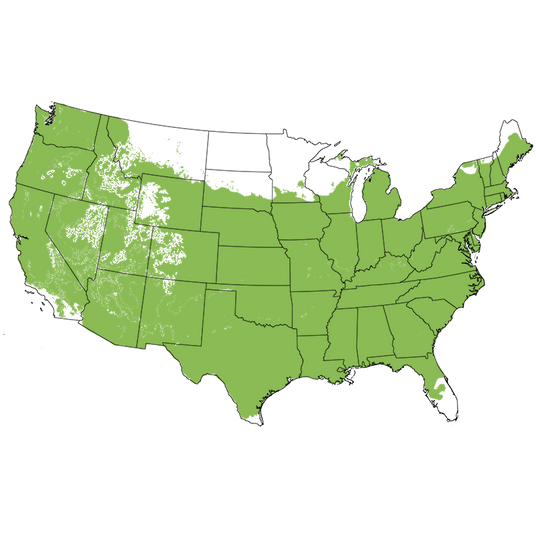
Growing Zones 5-9
America's Oldest Heirloom Newtown Pippin Apple Tree
- Late Season
- Oldest American Heirloom Selection
- Very High Quality American Apple
- Grown by George Washington and Thomas Jefferson
- Prolific Harvest
- Incredible Flavor
- Extremely Versatile
- Great for Baking, Fresh Eating, Sauces, Juicing or Hard Ciders
- Long Storage Life
Way back when America was being settled, fruit trees were grown for their intense flavor and productivity. If a tree was a heavy producer, and had a fine flavor, it got spread about both by bareroot and scion.
We are thrilled to offer America's Oldest Heirloom Apple trees from our expert growers. But, we know they'll be in high demand.
History buffs and foodies alike are keen to get their hands on this year's crop. Order this variety right now if you see it in stock.
Why do people crave the fruit from Newtown Pippin Apple (Malus domestica Newtown Pippin')?
Well for one thing, this is truly an all-American heirloom selection of apple that dates back to the mid-1600's. With outstanding, sweet-tart flavor, it gained much early attention.
Secondly, you couldn't find a more useful apple variety. From its earliest reviews, this unique heirloom apple variety was considered one the best all-around apples of the time.
This is a prized apple for pies and tarts. And the fresh eating, desert quality of the Newtown Pippin is famous throughout the world.
It's also one of the sought-after varieties for sauces and juicing. And there is no better for a homemade batch of hard cider for the Holidays. As a blending apple, Newtown Pippin is unmatched.
It was found as a chance seedling in the town of Newtown on Long Island east of New York City. You might hear it called Albemarle Pippin, after the county it was developed in.
This incredible apple variety would quickly rise to national popularity, and by 1773 was widely celebrated throughout the land.
The versatility of this fruit caught the eye of both George Washington and Thomas Jefferson, who planted Newtown Pippins at their estates. Benjamin Franklin shared the apple's superior flavor with Queen Victoria of England when he brought some on a visit. After that, the Queen waved all tariffs on Virginia apples.
It ripens in the late season and stores beautifully. You'll harvest Newtown in mid-October or a bit later. This good keeper is a storing apple that just gets better the longer it stays in a cool, dark place.
The one attribute the Newton Pippin lacks is eye appeal. With a patchy, greenish-yellow skin and an odd, rather oblong shape; no one will be awarding this variety any prizes for beauty. But boy, oh boy, you'll love the taste!
Order yours now, you don't want to miss out on this year's crop.
How to Use Newtown Pippin Apple Trees in the Landscape
The fruit will hang on the tree for over a month after reaching full ripeness. That makes an easy harvest for you!
The apples will be very hard when first picked and will develop additional sweetness in storage. Keep them for up to 3 months in a cool, dark place as the starches turn to sugar.
Enjoy the Newtown Pippin Apple's wonderful aroma and sweet flesh. There is a beautiful balance of sweetness with just enough tart to give it zip and tang. This is a great variety for fresh eating during winter.
This is the perfect blending apple. Mix Pippin with other tart green apples for amazing pies and cobblers. It's a must for juicing and cider.
This is an apple suited to the warmer climates with a very low chill requirement. It's also well adapted to zones 5 - 8, and is showing promising results in 9b and 10 a and b.
Please note, Granny Smith is better equipped to tolerate the heat spikes of 9a.
Pollinate with a favorite crabapple selection such as the Dolgo Crabapple. Or, pair this late season variety with an early ripening selection like Gala, a mid-season selection like McIntosh, and a later ripening Fuji. You'll enjoy apples for 4 to 5 months out of the year.
Use as a hard-working accent in a hedgerow. You'll space trees 5 feet apart to create a solid screen. Measure from the center of one tree to the center of the next.
For backyard orchard culture, be sure to check out our videos on our YouTube channel.
#ProPlantTips for Care
Apples will tolerate wet soil, as long as it drains quickly. Look for full sun locations that receive the early morning sun. This is the drying sun and works best to keeps your tree healthy.
Please make sure your trees receive plenty of air circulation. Prune in winter to keep the canopy open. The goal is to improve air flow and allow for better sun penetration.
Prune in summer to control the overall height and spread of the tree. We recommend keeping all fruit trees below 10 feet tall for ease of maintenance and harvest.
Provide a layer of mulch 3 to 4 inches deep, spread out 3 feet from the outside of the canopy. This will help to keep root system cool and cut down surface evaporation. This will help to extend the period between watering, and help you save on water.
There is nothing like this amazing heirloom apple variety. Add one or more to your garden and experience the finest taste treat of our Founding Fathers.
Newtown Pippin is one-of-a-kind and may just be the finest apple ever grown. They are in limited supply, order yours right now.
Newtown Pippin Apple Tree Frequently Asked Questions
When to Plant Newtown Pippin Apple Trees
Planting Bareroot trees as soon as you can dig a hole in spring and until hot weather, the earlier the better. Plant container Apple trees throughout the growing season with complete success - that is the benefit of container plants - to extend the planting season. Your County Agricultural Extension Office is a great resource for first and last frost dates in your area.
How to Plant Newtown Pippin Apple Trees
Dig a large hole only as deep as needed to accommodate the bareroot or container root ball, and twice as wide. Add Nature Hills Root Booster to speed root establishment. Remove the pot or bag and situate it into the hole so the top of the soil (soil line if bareroot), is level with the new location's soil being careful not to plant too deep. Water in again very well and backfill with the same soil you dug up, tamping down gently to ensure there are no air pockets.
Top off with a 3-4 inch thick layer of Arborist mulch. Consider staking your tree to keep its trunk growing straight for the first year to ensure it stands tall against strong winds and drifting snow.
When to Prune Newtown Pippin Apple Trees
Trim off any broken branches from delivery as soon as you take them out of the box. Prune and trim apple trees while dormant, in late winter or early spring, before you see new growth.
How to Prune Newtown Pippin Apple Trees
Dormant prune to:
- Remove any double leaders or narrow crotch angles
- Eliminate any crossing branches
- Thin interior branching and leave the fruiting spurs and strong branches in place opening up the canopy
- Branching at least 24-36 inches above the ground
Prune Apple trees in the summer to:
- Control size and shape by reducing the length of longer new growth on vigorous trees
- Remove water sprouts on the main trunk or older branches in the crown
- Remove suckers at the base of the trunk
- Thin fruit during heavy years on established trees
How to Care for Newtown Pippin Apple Trees
Growing an apple tree is easy when proper soil, good drainage, attention to moisture, and regular fertility are maintained. Once you've chosen an apple tree that works for your climate, in the size you need for your landscape, and its pollinator (if needed), then you've accomplished half the battle!
- Apple trees do best in full sun and well-drained soil
- Water your apple trees when it gets dry - especially during the fruit production stage, and drought periods to keep it stress-free
- Use arborists' wood chips to mulch over the roots of your apples and have your soil tested to see what your soil may be lacking before adding fertilizers
- Maintenance pruning and shaping
Apple trees will tolerate a wide range of soils, so long as water and nutrients are not limited and the pH level is adequate.
How to Fertilize Newtown Pippin Apple Trees
For the first year, water alone is most important. It is always best to get a soil test to see what your soil is lacking before adding more fertilizers. Once established, a fertilizer routine may be beneficial. We do offer some excellent slow-release organic options, applied according to the package directions.
Fruit trees need more phosphate and it's possible to apply too much nitrogen which affects the soil's pH. Test soil acidity or alkalinity using a pH Tester.
Fertilize in spring when you first see new growth emerging.
- Don't overdo it
- Phosphates are your friends
- Pay attention to pH in areas with extremely high or low soil pH
- Follow the directions
Newtown Pippin Apple Tree Pollinating Info
Newtown Pippin is not self-fruiting and needs a pollinating partner. Pair with one of these varieties:
Harvest Times for Newtown Pippin Apple Trees
Newtown Pippin’s are typically ready to harvest in October.
Early-Season? Mid-Season? Late-Season? The terminology can be confusing for new apple tree growers. Weather, climate and your tree determine when it's ripe.
For Apples:
- Early-season is usually June-July
- Mid-season can be August-September
- Late-season can be from late September-November
The growing season consists of spring, summer, and fall, and varies with climate and weather. Areas with longer growing seasons in the warmer hardiness zones can greatly affect the harvest times for each particular apple variety grown in your area.

